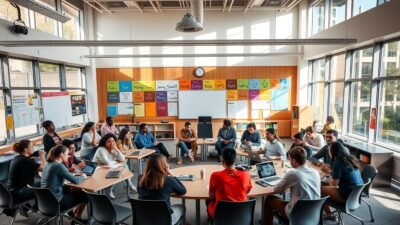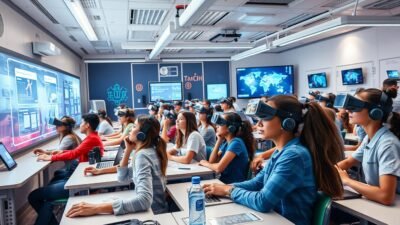India’s journey towards inclusive education is paved with legal frameworks and societal challenges. This path aims to embrace all learners, regardless of their abilities. It’s a true measure of the nation’s commitment to education.
Inclusive education is transforming India’s educational landscape. It creates learning environments where every child can thrive, regardless of abilities. The legal framework supporting this vision is crucial for accessibility.
Schools across India are working to implement inclusive practices. Understanding the legal basis is key to this process. India’s legal system provides a strong foundation for inclusive learning.
Laws mandate equal educational opportunities for all students. They also guide the creation of resources for diverse needs. From constitutional provisions to specific acts, these laws shape inclusive education.
Preparing for the UGC NET exam can be a daunting task, but with the right resources, candidates can navigate the process effectively. Websites like MyJRF provide a comprehensive platform for aspiring educators, offering specialized guidance for UGC NET Paper 2 preparation and essential tips for acing UGC NET Paper 1. Additionally, understanding the revised syllabus provided by UGC is crucial for a targeted study approach. For official announcements and updates, candidates should regularly visit the UGC NET NTA portal, while the UGC’s job section and the main UGC website are invaluable for post-exam opportunities and academic resources. With these tools, candidates can maximize their preparation and set themselves up for success.
Key Takeaways
- Inclusive education is a priority in India’s educational system
- Legal frameworks support equal learning opportunities for all students
- Constitutional provisions form the basis for inclusive education policies
- Specific acts guide the implementation of inclusive practices in schools
- Educational resources are being developed to cater to diverse learning needs
The Importance of Inclusive Education in India
Inclusive education shapes India’s learning landscape. It creates an environment where all students learn together, regardless of abilities.
Definition and Scope
Inclusive education in India welcomes and supports all learners. It embraces diverse learning needs beyond traditional classroom settings.
The scope includes:
- Adapting teaching methods
- Modifying study materials
- Creating accessible learning spaces
- Promoting social integration
Benefits for Students with Disabilities
Inclusive education offers many advantages for students with disabilities:
| Benefit | Description |
|---|---|
| Enhanced Social Skills | Interaction with peers fosters better communication and relationships |
| Improved Learning Outcomes | Tailored support leads to better academic performance |
| Increased Self-esteem | Participation in mainstream activities boosts confidence |
| Future Opportunities | Better preparation for higher education and employment |
India takes a big step towards equality in learning. This approach benefits students with disabilities and enriches everyone’s educational experience.
It creates a more inclusive society. Diversity is celebrated, and every individual’s potential is recognized.
Historical Context of Inclusive Education Policies
India’s inclusive education journey spans decades. It reflects changes in educational philosophy and policy. These policies show how India’s approach to education for all students has evolved.
Pre-Independence Educational Framework
Before independence, education in India was mostly exclusive. Elite schools served the privileged, while many lacked access to formal education. Degree options were few, and students with disabilities were often left out.
Post-Independence Developments
After 1947, India’s education scene changed dramatically. The government made universal education a priority. They expanded schools across the country. New degree programs emerged to meet diverse needs.
Policies began addressing the needs of students with disabilities. The 1960s introduced integrated education, opening doors for inclusive practices in schools.
In the 1990s, India signed international declarations promoting education for all. This led to major policy shifts. Schools were urged to become more inclusive.
Today, India aims to create an education system for all. The goal is to ensure quality education for students of all abilities.
Key Legal Documents Supporting Inclusive Education
India’s legal framework supports inclusive education through three key documents. These documents ensure educational rights for all children, including those with disabilities.
The Constitution of India
The Constitution ensures equal educational opportunities for all. Article 21A guarantees free and compulsory education for children aged 6-14. This right applies to every child, promoting an inclusive learning environment.
The Right of Children to Free and Compulsory Education Act
The RTE Act builds on the constitutional right to education. It requires schools to provide free education and quality learning resources. The act also addresses the needs of disadvantaged groups, fostering inclusivity in classrooms.
The Persons with Disabilities Act
This law focuses on the rights of individuals with disabilities. It mandates educational institutions to provide support for students with special needs. The act aims to remove barriers and ensure equal access to education.
| Legal Document | Key Provisions for Inclusive Education |
|---|---|
| Constitution of India | Right to education for all children aged 6-14 |
| RTE Act | Free education and quality learning resources |
| Persons with Disabilities Act | Support and accommodations for students with special needs |
These legal documents form a strong foundation for inclusive education in India. They work together to ensure quality learning experiences for all children. Regardless of abilities, every child has access to educational resources and opportunities.
Roles of Government and Educational Institutions
In India, the government and schools work together to make education inclusive. They strive to create a learning space where all students feel welcome and supported.
National Policy on Education
The National Policy on Education guides inclusive practices across India. It focuses on equal access to quality education for all children. This policy helps schools create inclusive lesson plans and teaching methods.
State Government Initiatives
State governments create programs to meet local education needs. They train teachers in inclusive methods and provide resources to schools. Many states run campaigns to promote acceptance of diverse learners.
School-Level Implementation
Schools lead the way in putting inclusive education policies into action. They adapt their buildings, teaching styles, and tests to suit all students. Teachers learn how to create inclusive classrooms and address individual needs.
- Modifying school buildings for accessibility
- Providing assistive technologies
- Developing individualized education plans
- Creating peer support systems
Teamwork between government and schools is vital for inclusive education in India. Together, they create chances for all students to learn and grow.
Challenges in Implementing Inclusive Education
Inclusive education in India faces big hurdles despite legal support. These issues affect learning quality and resources for all students.
Attitudinal Barriers
Mindsets are a major roadblock to inclusive education. Many teachers and parents have wrong ideas about disabilities. This leads to pushback against mixed classrooms.
| Attitude | Percentage of Teachers |
|---|---|
| Hesitant to teach students with disabilities | 62% |
| Believe separate schools are better | 47% |
| Lack confidence in inclusive teaching | 73% |
Infrastructure Limitations
Physical barriers in schools block inclusive learning. Many Indian schools lack proper facilities for students with different needs.
- Absence of ramps and elevators
- Inaccessible toilets and drinking water facilities
- Lack of assistive technologies and learning aids
These gaps limit access to good education for students with disabilities. This impacts their overall learning experience.
The Role of Teachers in Inclusive Classrooms
Teachers are key to creating inclusive classrooms. Their skills and attitudes shape learning for all students. This is especially true for those with diverse needs.
Let’s look at how professional growth and teaching methods support inclusive education.
Professional Development and Training
Ongoing learning is vital for teachers in inclusive settings. It gives them tools to support all learners well. Many schools offer workshops on inclusive practices.
Online options have made professional growth more accessible. Teachers can now improve their skills without disrupting their schedules.
Inclusive Teaching Strategies
Effective inclusive teaching uses diverse methods to meet all students’ needs. Here are some key approaches:
- Differentiated instruction: Tailoring teaching methods to individual learning styles
- Universal Design for Learning: Creating flexible learning environments
- Cooperative learning: Encouraging peer support and collaboration
- Assistive technology: Using tools to support students with disabilities
These strategies help create a classroom where every student can thrive. Teachers who master these approaches can boost learning for all students.
| Strategy | Benefits | Challenges |
|---|---|---|
| Differentiated instruction | Meets individual needs | Time-consuming planning |
| Universal Design for Learning | Flexible for all learners | Requires redesign of materials |
| Cooperative learning | Promotes social skills | Managing group dynamics |
| Assistive technology | Enhances accessibility | Keeping up with new tools |
By using these strategies, teachers can create truly inclusive classrooms. Continued professional growth helps them benefit all students.
Community Involvement and Support
Community involvement is crucial for inclusive education in India. Schools can create supportive learning environments by engaging parents, families, and organizations. This approach enhances resources and promotes inclusivity.
Collaboration ensures quality learning opportunities for all students. It helps provide access to resources regardless of abilities.
Engaging Parents and Families
Schools can increase parental involvement through regular communication and workshops. These events help families understand inclusive education’s importance. They also learn how to support their children’s learning at home.
Parent-teacher meetings offer chances to discuss progress. They also provide opportunities to address any concerns.
- Organizing inclusive school events
- Creating parent support groups
- Providing resources on inclusive practices
- Encouraging volunteer opportunities
Role of NGOs and Civil Society
NGOs and civil society groups promote inclusive education across India. They often connect schools, families, and communities. These organizations make valuable contributions to inclusive education.
- Offering specialized training for teachers
- Developing inclusive learning materials
- Advocating for policy changes
- Raising awareness about disability rights
Communities can create a more inclusive educational landscape by working together. This teamwork ensures all students have access to quality learning opportunities.
Evaluation and Assessment of Inclusive Education
Evaluating inclusive education is vital for its success in India’s diverse learning landscape. It involves measuring progress and using tools to gauge impact on student outcomes. This process ensures effectiveness in meeting all learners’ needs.
Measuring Success and Progress
Successful inclusive education goes beyond academic achievement. It includes social integration, personal growth, and overall well-being of all students. Schools can track progress through various indicators.
These indicators include academic performance of students with disabilities and social interactions among diverse learners. They also cover participation in extracurricular activities and teacher satisfaction and growth.
- Academic performance of students with disabilities
- Social interactions among diverse learners
- Participation rates in extracurricular activities
- Teacher satisfaction and professional growth
Tools for Assessment
Educators use various tools to evaluate inclusive education practices. These range from standardized tests to observational methods. Some effective assessment tools are listed below.
| Assessment Tool | Purpose | Benefits |
|---|---|---|
| Individualized Education Program (IEP) | Track personalized learning goals | Tailored to each student’s needs |
| Classroom Observation Checklists | Evaluate inclusive teaching practices | Provides real-time feedback |
| Student Self-Assessment Surveys | Gather learner perspectives | Promotes student voice and agency |
| Peer Review Assessments | Assess social integration | Encourages collaborative learning |
Schools can create a comprehensive picture of their inclusive education efforts using these tools. This data guides future strategies for improvement. It ensures better learning and study materials for all students.
Case Studies: Successful Models of Inclusive Education
India has made great strides in inclusive education in urban and rural areas. Let’s look at some inspiring case studies from academic institutions across the country.
Innovations in Urban Schools
Mumbai’s Gateway School has created a unique inclusive education model. They’ve added special support services to regular classrooms. This helps students with different needs learn with their peers.
Delhi’s Amar Jyoti School has also found success with inclusive education. They use a buddy system to pair students without disabilities with those who have special needs. This approach has helped create a more inclusive learning environment.
Rural Inclusive Education Initiatives
Rural areas face unique challenges in inclusive education. Satya Special School in rural Tamil Nadu has created mobile therapy units. These units bring special education services to remote villages.
The Educate Girls program in Rajasthan focuses on gender equality in education. They’ve successfully integrated girls with disabilities into regular schools. This breaks down both gender and disability barriers in rural education.
| Initiative | Location | Key Innovation | Impact |
|---|---|---|---|
| Gateway School | Mumbai | Integrated support services | Improved academic and social skills |
| Amar Jyoti School | Delhi | Buddy system | Enhanced empathy and inclusion |
| Satya Special School | Rural Tamil Nadu | Mobile therapy units | Increased access to specialized education |
| Educate Girls | Rural Rajasthan | Gender-focused inclusion | Improved enrollment of girls with disabilities |
These examples show that inclusive education can work in many different settings. They offer inspiration for other schools looking to create more inclusive learning spaces.
Future Directions for Inclusive Education in India
India has made great progress in inclusive education. Yet, there’s still work to be done. We need better policies and practices for fair learning.
Policy Recommendations
Policymakers should focus on thorough teacher training programs. These programs should teach skills for diverse learning needs. More resources are needed for adaptive tech and accessible buildings.
This approach will help schools support students with different abilities. It’s crucial for creating an equal learning space for all.
Emphasizing Sustainability and Equity
Long-term planning is key for sustainable inclusive education. Schools should create custom plans for students with special needs. This ensures personalized learning for everyone.
Awareness campaigns can help change society’s views. They can foster a culture of acceptance and inclusion. This is vital for true educational equity.
Teacher and admin development is crucial for inclusive education. This investment will improve learning for all students. The goal is an education system that includes every child.
FAQ
What is inclusive education in India?
Inclusive education in India integrates students with disabilities into mainstream classrooms. It provides equal learning opportunities for all students. This approach is backed by laws ensuring quality education for every child.
What are the key legal documents supporting inclusive education in India?
The Constitution of India guarantees the right to education for all. The RTE Act mandates free education for children aged 6-14. The Persons with Disabilities Act ensures equal opportunities in educational settings.
How has inclusive education policy evolved in India?
Inclusive education in India has shifted from segregated special education to inclusive practices. This change has been gradual, with major milestones along the way. The National Policy on Education and government initiatives have shaped this evolution.
What role do teachers play in inclusive classrooms?
Teachers implement inclusive strategies and adapt curriculum for diverse learning needs. They create supportive environments for all students. Ongoing training helps teachers manage inclusive classrooms effectively.
What are the main challenges in implementing inclusive education in India?
Attitudinal barriers and infrastructure limitations pose challenges to inclusive education. Lack of specialized teacher training and insufficient resources are also major hurdles. Overcoming these issues requires efforts from government, schools, and communities.
How is the success of inclusive education measured in India?
Success is measured through student performance, social integration, and overall well-being. School-level indicators like enrollment rates and teacher training are also considered. These metrics help gauge the effectiveness of inclusive education initiatives.
What is the role of community involvement in inclusive education?
Community involvement is crucial for inclusive education’s success. This includes engaging parents and collaborating with NGOs. Fostering a culture of acceptance within local communities supports inclusive practices.
Are there successful models of inclusive education in India?
Yes, successful models exist in both urban and rural settings. Urban schools have integrated students with disabilities effectively. Rural initiatives have overcome resource constraints to provide inclusive education.
What are the future directions for inclusive education in India?
Future directions focus on addressing current challenges and building on successes. This includes improving teacher training and enhancing infrastructure. Promoting awareness and acceptance of inclusive education principles is also crucial.
How does distance learning impact inclusive education in India?
Distance learning provides greater access for students with mobility issues. However, it presents challenges in digital accessibility. Developing inclusive online learning strategies is crucial for equitable education.





